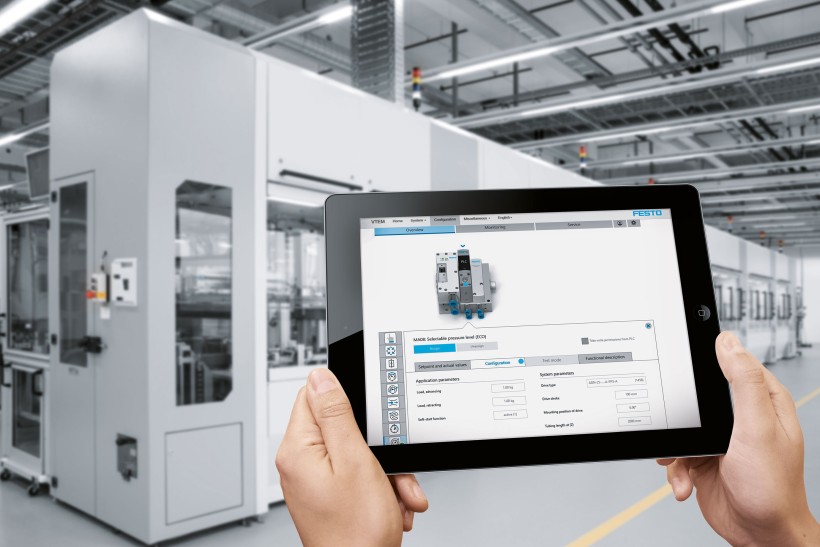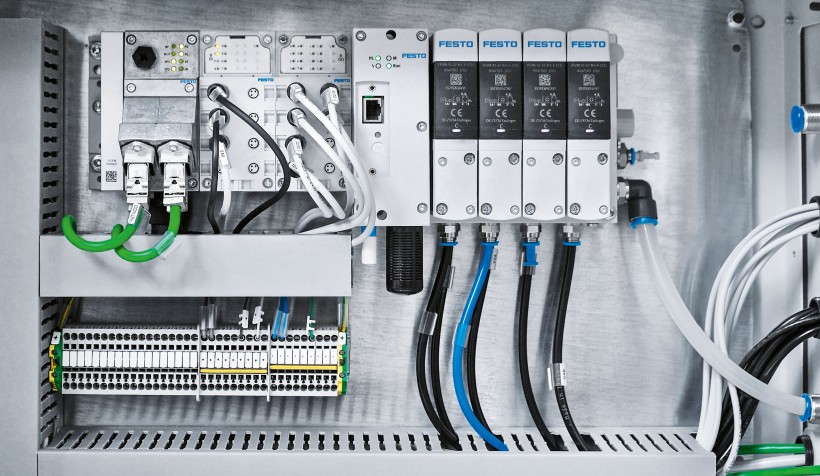Best Practices
The following applications serve as examples of the variety of freely combinable motions that are possible with the Motion Terminal, including for retrofitting your system. Prepare to be inspired
Highly Flexible Pick & Place
With the Motion Terminal VTEM, you can implement all the functions of your pick-and-place application in just one system. This means you no longer need numerous components such as shock absorbers, flow control valves, etc.
Since Motion Apps now perform various tasks and replace complex mechanical setups, the design process becomes much easier. To ensure that quality remains consistent, you can easily access the process data at any time and quickly respond to any deviations.
Simultaneously Run Multiple Complex Machining Processes
The “Selectable Pressure Level” Motion App allows you to control up to eight double-acting cylinders that simultaneously perform multiple machining operations on a plastic tank. Digitalized pressure control allows the correct working pressure to be set for each individual cylinder – without the need for external sensors. This maximizes process reliability and saves compressed air in many places.
Control More Flow Rates Simultaneously
The “Flow Control” Motion App makes the process of filling containers such as bottles with nitrogen or other gases more cost-effective. The app allows you to control the flow rate for up to eight channels simultaneously. Thanks to precise dosing, you also save a significant amount of nitrogen. Digitalized nitrogen control is tamper-proof, flexible, and, thanks to the “Selectable Pressure Level” Motion App, even shortens cycle times.
Smooth and Vibration-Free Swiveling
The Motion Terminal allows you to load workpieces, for example into presses, more smoothly, quickly, and efficiently. The virtually vibration-free motion significantly shortens cycle times and at the same time extends the system’s lifetime. Pressure during the empty return stroke is low to optimize energy consumption.
Reliable Machine Tooling Operations
In this application, the Motion Terminal enables you to achieve several objectives at the same time: from individual tool gripping to accelerated opening and closing of the safety doors to contact monitoring in order to optimize the workpiece machining process.
Press in Flexible Materials Quickly and Reliably
Dynamically adjusting the pressure via the “Selectable Pressure Level” app allows you to achieve maximum process quality when pressing in flexible materials, such as airbags into cartridges. Compared to conventional pneumatics, this greatly simplifies the design process – and allows you to conveniently duplicate parameter sets.
Flexible Gripping with End-of-Arm Tooling
Robots can perform a wide range of tasks by simply changing the end-of-arm tooling (EOAT), which is equipped with various components. The Motion Terminal makes it easier for you to leverage this flexibility during operations – no matter how many EOAT components you use on one robot, the Motion Terminal controls them all from a single location. This makes both designing and bringing the system into operation easier.
Intelligent Control for Constant Web Tension
Whether textiles, film, or paper – the intelligent, digitalized control of the dancer roller ensures that web tension always remains constant. The “Proportional Pressure Regulation” Motion App immediately compensates for tension fluctuations in the belt. Real-time system monitoring – even via remote diagnostics – significantly increases the reliability of the process.
Safe, Gentle, and Fast Handling of Delicate Components
By combining the “Positioning” and “Proportional Pressure Regulation” Motion Apps, you can resolve the conflict between speed and safe transportation. The video demonstrates how this works when handling extremely delicate wafers. The two Motion Apps are synchronized so they each play to their strengths at precisely the right points in the process.
Example from the Field: Designer Fashion Perfectly Combines Handcraftsmanship and Industry 4.0
The requirements were straightforward: a new machine for producing credit card slots in wallets needed to offer maximum flexibility, short cycle times, and optimize the use of materials. Autec, a manufacturer of automation equipment for shoe and leather goods factories based in Pisa, Italy, developed the machine for a renowned Italian brand. As an ideal solution to meet these requirements, the company selected the Festo Motion Terminal.
Rapid Reconfiguration Required

Autec needed an easily reconfigurable component for the new machine. It needed to be possible to easily change the function and flow rate of the valves – and at the same time control them remotely – as is the case with the app-controlled Motion Terminal.
The software and apps played a pivotal role in the implementation of the system. They determine the functions of the valves and significantly contribute to the flexibility of the machine.
In addition, the various tools and the operation of the machine as a whole can be controlled remotely via app. Ilario Barsacchi, engineer and PM at Autec, explains: “Reconfiguring the Festo Motion Terminal is now extremely fast. Instead of ordering, installing, and reconfiguring additional proportional valves, all we have to do is activate an app.”
Ultrafast Folding of Credit Card Slots

Autec’s new machine controls the process of gluing together two parts, one made of leather and one made of silk. A servo robot then transfers the bonded pieces to a leather folding machine. “In this space-saving compact solution, eight credit card slots are glued and folded in only 14 seconds,” continues Barsacchi.
Numerous Functions in One Valve – Thanks to Apps

Since the valves can be used both as proportional valves and as control valves, the Motion Terminal makes it possible to quickly change the function of the tool from a suction gripper head to a gripper head with a pin clamp. In other words, the system is like a piece of hardware that can be reprogrammed again and again via software components that are simply adapted to the application in question. The days in which a valve had only one function are long gone. Management software was also developed for this machine and installed on a PLC, which serves as an interface for controlling the device. The entire process was extremely simple and posed no difficulties whatsoever.
Zero Defects, Maximum Material Utilization
This genuine Industry 4.0 solution has eliminated the inherent susceptibility to errors associated with manually producing these credit card slots and maximizes the use of the available raw material.